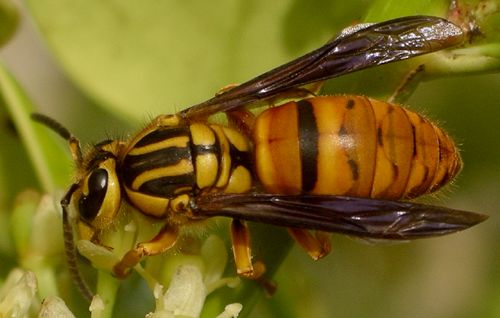by Valerie
March, 2011Southern Yellowjacket Queen
At this time of year it is not unusual to see wasps feeding at flowering shrubs. The queen southern yellowjacket (Vespula squamosa) shown above is doing just that. It is a well-known fact that many species of wasps are lured to sweets (don't leave a soda can unattended during the summer and then drink from it without using caution) but people are often surprised to see wasps feeding alongside of honeybees and butterflies. Adult wasps do feed on nectar, but they do not collect pollen for their babies the way bees do. The larvae of wasps need flesh, and that is why wasps are considered beneficial in the control of pests such as caterpillars. Yellowjackets are social, with a single queen starting a colony in the spring that will later contain her daughters (workers) and, much later in the fall, males (drones) and future queens. Only the queens survive through the winter, hibernating under rocks or in other safe places. Once the weather warms up enough, the queen will venture forth and start a colony, usually in the ground, under wood piles, or beneath stones. She also needs to eat as well as hunt for her first offspring. She will catch caterpillars or other suitable prey and take it back to the nest for the maturing grubs. Once her colony includes workers, they will do the hunting for the babies. Sometimes we have very mild winters and yellowjacket nests survive through to the next year. They simply grow bigger and bigger. I saw one colony in a large woodpile that lasted at least two years and eventually had several openings spread over an area two feet in diameter and a constant stream of workers coming and going. Here in central Texas, we have two common species of Vespula, the other being the eastern yellowjacket. There are instances in which a southern yellowjacket queen will take over a young colony of eastern yellowjackets, kill the existing queen and coerce the workers into caring for her own brood. This might explain why I find southern yellowjackets more often than their cousin species. |